TRE Workshop: Aesthetics and Territoriality
The second TRE (Transnational Radio Encounters) Workshop »Aesthetics & Territoriality« started with a public day in the marvelous premises of the Funkhaus Nalepastraße.
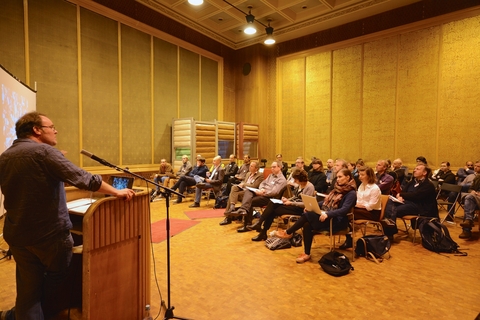
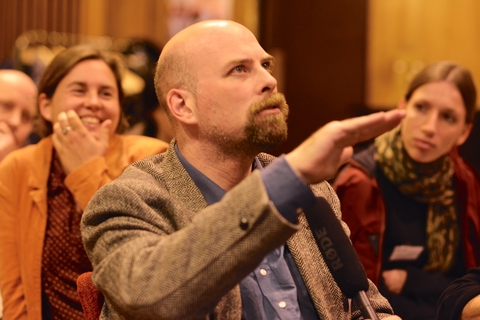
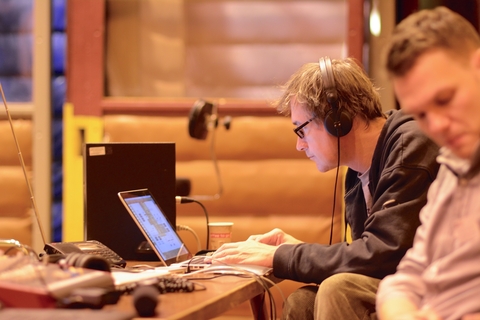
We focused on sound aesthetics as a means of acoustically marking territories through radio. This focus is one key aspect of a larger project that aims to relate different forms and effects of transnational radio practice and view them from different national historical backgrounds.
The presented studies and theoretical positions are not only part of TRE, they are also pieces of a jigsaw of another endeavour, the research network »Radio Aesthetics - Radio Identities«. Its goal is to find appropriate methods, theories and models for the description of recurring schemes and principles that together shape the individual ›sound‹ of a single radio station or program.
In the terminology of German radio practitioners this perception of a specific ›sound‹ of a radio station is often termed ›Anmutung‹, a word hardly translatable at all, and quite a bit oldfashioned. It is in fact close to Walter Benjamin's ›aura‹, but without Benjamin's idea of absolute uniqueness and thus maybe best grasped as ›impression‹ or ›look and feel‹. This term positions the phenomenon close to Gernot Böhme's concept of ›atmospheres‹, describing relationships between qualities of whole environments – be it rooms, streets or media – , supplying a background to foreground events and usually perceived subconsciously. These atmospheres are understood to evoke affectivities, influencing moods, levels of attention, attitudes, judgements etc.
Anglophone practitioners on the contrary (as far as I can tell mostly US-Americans), use the term ›stationality‹, pointing to a maybe more pragmatic idea of marking a station as a unique product with a coherent, overarching audio branding of a station as a social and economic entity.
Principally both terms do mean the same thing: The empirical reality that most listeners can easily tell certain stations or station types from others when having to choose what they would like to listen to or when they are asked. They even, as a study done by Luise Gebauer at the University of Halle proved, are well able to articulate a wide range of charactertistics that influence categorisations and qualities they perceive. And this usually automatically executed process even works when listening only for a second, or for instance when overhearing a radio signal in a din of street noises, thus even when listeners are unable to identify the topics spoken about.
However, the use of two rather different terms in two countries or languages can be suspected to point to an actual difference, either in the ways radio is listened to in the radio culture of the respective countries, or in the sound qualities present on the respective airs, or both.
Radio as a Sound Medium
We can apply modes of radio listening, as developed by Susan Douglas or Kate Lacey, to better understand the perceptive attitudes that preconfigure what is finally constructed in the listener's mind as ›a specific radio program‹, and how listener's reactions to the program are fed back on how radio is made in a given place and time. And we can describe technical and institutional environments in order to analyze economic, political or for instance subcultural influences on radio practice and its results.
But if we understand a radio program to be more than a) preconfigured content from other sources – as in the case of hit music played on air – and b) journalistic, educating, cultural and entertaining content packed into language – as in the case of moderation, news, pieces etc. –, then we have to look further than this and include several aesthetic, atmospheric – which in radio means: sound-borne – characteristics.
Using the ›sound‹ term as a concept describing the auditive ›aesthetic surface‹ of radio, directs our focus on four areas apparently relevant for radio sounds:
- Characteristic ways of speaking, including rhetorical tropes as well as patterns of pronunciation and prosodic features like pitch, tempo and types of voice modulation
- Characteristic arsenals of non-vocal sound material, including the all-important choice of music genres as well as originally produced ›packaging elements‹ like jingles, station IDs, signatures etc.
- Characteristic ways of sequencing and mixing broadcast elements into a ›broadcast flow‹, resulting in rhythmic patterns, specific densities and spectral properties
- Characteristic overall spectral sound qualities as they are shaped by typical studio tools for filtering, dynamic compression, aural enhancing etc.
What we are trying to grasp methodically and describe systematically is this notion of ›the sound‹ of an individual radio station and a specific type of program. These, of course, have to be understood in their respective contexts.
Territorial Differences and Resemblances
As for instance Kate Lacey and Shawn Gary VanCour have shown, a broad spectrum of national contexts – including technological, economical, regulatory and cultural dispositions and changes – most basically shape how radio is made, distributed and heard. The commercial structure present from the ground up in the USA differs in many aspects from a more educational concept of the british early BBC and a »cultural« – and thus unpolitical – idea of radio as institutionalized in Weimar's Germany.
At the same time, radio was the first medium to so incredibly easily cross borders and spread, maybe not so much by the impact of words but even more so on the wings of its radiophonic sound, to other countries, inspiring people's ideas about foreign mentalities, political attitudes and even general anthropological conditions, as we can read it for instance in Rudolf Arnheim's early reflections on radio.
So we can state that radio, probably just like all other media,
- on the one side develops national characteristics, typical for reasons of language, political system and cultural heritage
- on the other side have some sort of transnational effects, interconnecting individual citizens around the globe and loosening up the strength of political boundaries.
We are looking at these effects, but thereby we are also asking in how far radio is in fact unlike other media, that is: What makes transnationality of radio different from transnationality of other media.
Approaches to Aesthetics and Territoriality
So what is it that we have to talk about? We have different types and techniques of producing broadcast elements, of blending the right mix and of technically processing the sound of a radio station. We assume this sound to bear marks of national infrastructure and cultural history. But we also assume this sound to bear marks of a transnational radio aesthetics, that spreads due to economical reasons just as well as to artistic considerations across the world. To gain insight, it is certainly helpful to direct our attention to a special choice of programs present in radio:
We can learn a lot from reflections on the sound of radio drama and radio feature, which are the best aesthetically researched items in radio, and at least from time to time they are setting standards because they impress us so much that some element – a voice or sound quality, a way of mixing different elements — is taken over into the regular, standard program.
- David Hendy and Jochen Meißner engaged in a dialogue about British and German radio drama and feature, trying to flesh out national sound aesthetics of these countries.
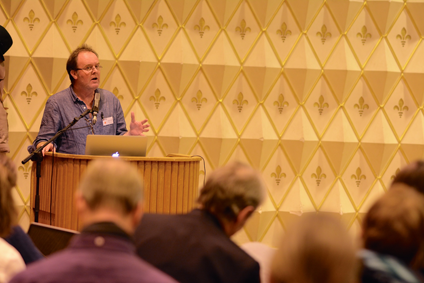
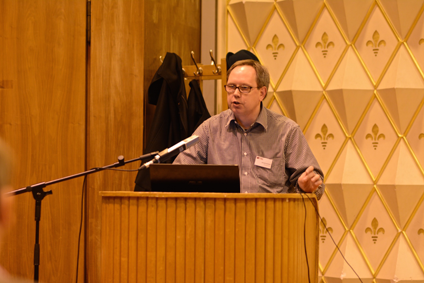
We can also learn from everyday and ›special‹ everyday programs, because they represent standards, which means that they colour our daily lives and burn into our nervous system so deeply that we can so easily recurr on these experiences that we understand well when this kind of everyday radio gets reprocessed in radio drama or feature, and when it gets cited in literature, music or film, as it happens quite frequently.
- To get a glimpse of the broad spectrum of this kind of everyday radio, we heard from Jacob Kreutzfeldt and Heidi Frank Svømmekjær about the sound of nordic radio in the pre-WW2 years, and from a group of Master students from the University of Halle and Golo Föllmer about today's sound of everyday radio from quite all around the globe.
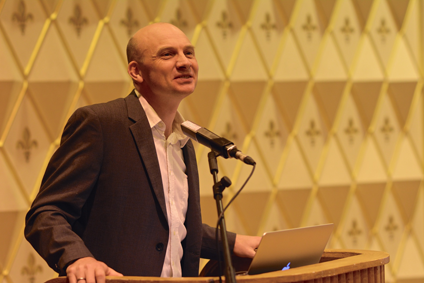
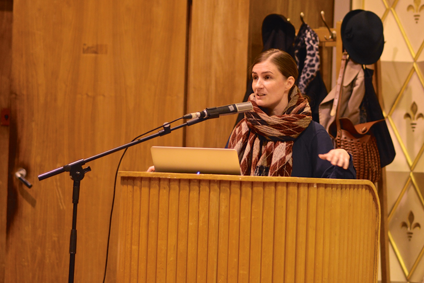
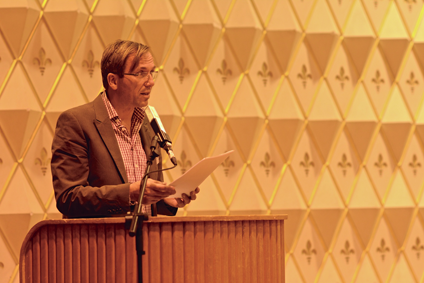
We also hoped to understand more about transnational radio by looking at broadcast attitudes and speech styles in multicultural programing or ›minority radio‹, since here members of cultural groups and expatriates from certain national backgrounds use radio to express and represent themselves using their specific accent, that way accenting – and forming – their identity.
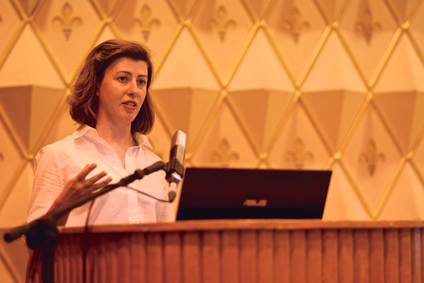
This day was completed by listening to some analytical radio art. Using snipets from actual radio programs, five radio artists in four sets and three groups played hand- and computer-made assemblages to one end: Distilling sounds of specific kinds of radio, thereby also getting to the bottom of making technology and the process of crafting audible.
- Jonas Olesen and Rasmus Cleve from Copenhagen played a Danish Radio DJ Set.
- Frank Schültge and Christian Berner first presented their award winning, disecting radio element mix ›Formal Radio‹ from 1999,
- followed by their remake ›Formal Radio Extra Cheese‹, a commission especially made for this day and nicely co-commissioned by Deutschlandradio Kultur.
- Givan Bela then gave all productive power into the hands of computers, letting them build a speculative radio stream in another commission produced for this day, ›Re-Rodia - mini cut-up procedures for automatic radio listener‹.
After that, a close talk about these pieces and procedures was held, circling around the questions: How were the pieces made? What makes a radio performance radiophonic? What did the makers hear in the material they used? The same as we did?
Latest activities for this project:
In our second workshop, we will focus on „Aesthetics and Territoriality“, asking questions about how local/regional, national or transnational/European identities are expressed, mediated, transmitted and perceived through radio. To what degree do radiophonic sound concepts follow characteristics of national cultures? How do they express territorial belonging or otherness? How are culturally specific auditive styles developed and maintained? To what extent limit transcultural styles, such as that of American commercial radio, the development of indigenous forms in Europe?
